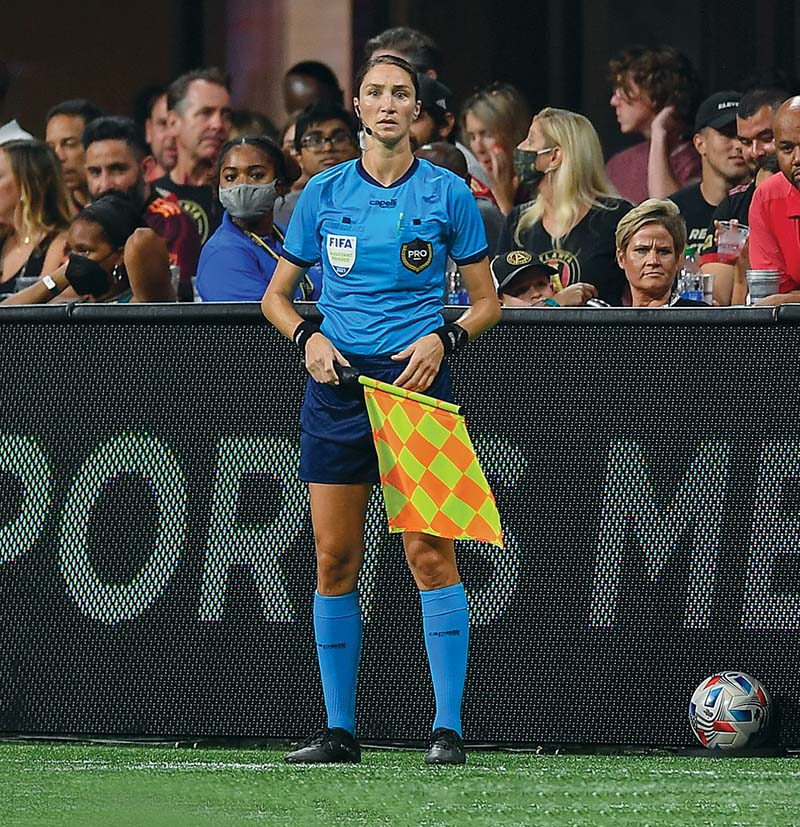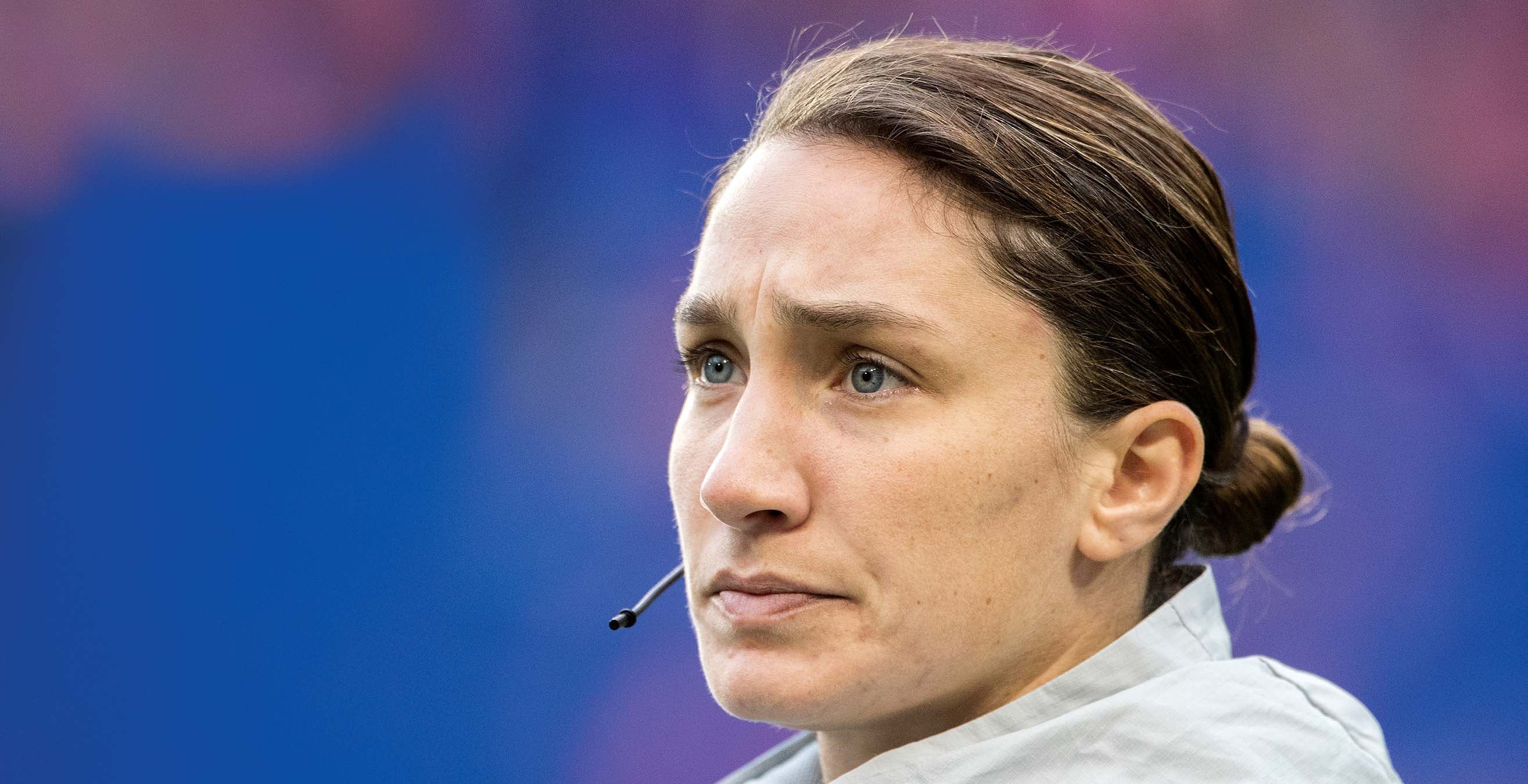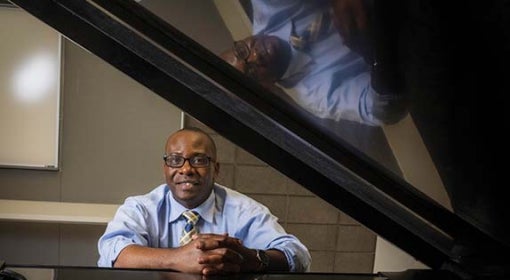To the roar of wildly cheering fans, Kathryn “Katy” Nesbitt walks onto the soccer pitch inside Stade Auguste-Delaune in Reims, France. The adoration isn’t for her, however. It’s for the athletes walking behind her — the Norwegian and Nigerian soccer squads — who are about to face off in the second match of the 2019 FIFA Women’s World Cup.
With a yellow-and-red checked referee flag in hand, Nesbitt doesn’t feel slighted in the least. Instead, she looks around at the passionate fans in the stands, more than 11,000 of them, and absorbs the moment. She’s about to be an assistant referee at the showcase international tournament for the best female soccer players in the world. Teams from 24 countries are competing in the monthlong event, which will be watched on television by about 1 billion people around the globe.
As an assistant referee, Nesbitt is expected to provide backup and advice to the head referee, keeping an eye out for fouls and making calls when the ball goes out of bounds or when a player is offside — all while continuously sprinting up and down her half of the pitch to follow the action.
Nearly a decade ago, Nesbitt couldn’t have imagined becoming an elite, full-time, professional soccer referee, let alone one now known for breaking gender barriers. Officiating at the top level is extremely competitive and difficult to break into. It’s also male dominated and, until very recently, a career from which women were simply excluded.
Besides, back then, the driven and extraordinarily energetic young woman was pursuing (and excelling at) a very different passion: chemistry.
Studying the complexities of the brain fascinated Nesbitt. How the organ functions on the chemical level, how ailments and injuries affect it — she was captivated by it all.
That’s why chemistry professor Adrian Michael’s lab felt like the perfect place for her doctoral studies, which she began at the University of Pittsburgh in 2010. Michael’s research group focuses on real-time chemical analysis in the central nervous system to generate new understanding not only of normal brain function but also of the pathology of various brain diseases as well as brain injury.
Nesbitt dug right in. Michael’s lab was developing sensors that would monitor brain chemistry to diagnose neurological diseases such as Parkinson’s and Alzheimer’s. Part of the research involved implanting sensors onto live brain tissue, which can sometimes react and reject the foreign objects placed upon it.
“Katy worked on the chemistry that suppresses that rejection,” recalls Michael.
The research meant long hours in the lab, which didn’t go unnoticed. “Katy was really fearless in terms of tackling tough experiments,” says Michael. “She was very creative and imaginative and always looking for the deeper interpretation of results.”
What Michael didn’t know, at least at first, was that Nesbitt was somehow also finding time to slip out of the lab just long enough to referee some home games for the Pittsburgh Riverhounds, the city’s professional men’s soccer team. “She tried to keep the referee part hidden from me because a grad student is supposed to be in the lab 24/7,” laughs Michael. “But I figured it out. Actually, I thought it was pretty cool and unique.”
Rather than being a distraction to the demands of graduate school, however, her time on the field made her a better researcher, Nesbitt recalls.
 “I could go to a soccer field and turn my brain off from chemistry for 90 minutes. And that was so healthy for me, to shut everything off and not have a million questions going through my head.”
“I could go to a soccer field and turn my brain off from chemistry for 90 minutes. And that was so healthy for me, to shut everything off and not have a million questions going through my head.”
Officiating started out as just a hobby for Nesbitt. She got involved in the work serendipitously, when she was just 14 years old. In her hometown of Rochester, New York, she was often forced to go to her brother’s soccer games. “I was bored out of my mind. My mom would make me go help the referee. I was a little kid helper. That’s how it all started.”
She would hold the flag, only waving it if the ball went out of bounds. Then one day the ref asked her, “Would you like to make some money doing this?”
She was interested, especially when she learned that the pay was $400 for a weekend tournament. She would need to take a refereeing course and pass a 50-question test to get certified. With that done, she was soon cashing in on the field. The job gave her a good cardiovascular workout, too — something that came in handy in her training as a figure skater, which she did through high school.
Like refereeing, her interest in chemistry happened more or less by chance. In high school, she became enamored with chemistry when her teacher did the classic blow-things-up experiment in front of the class. “Everyone would always say, ‘That’s my least favorite class.’ But it made a lot of sense to me. Put me in a lab, and I absolutely loved doing experiments.”
Nesbitt chose to study chemistry in college, earning a bachelor of science degree from St. John Fisher College in Rochester. She then went on to earn a PhD in chemistry from Pitt before embarking on a postdoctoral research fellowship at the University of Michigan.
It was in Michael’s lab in Pittsburgh, however, that the young scientist found some overlap between her two rather disparate worlds.
Perhaps the biggest occupational hazard of refereeing is the intense, sometimes downright insulting scrutiny that comes with it. There are often screaming players, gesticulating coaches and booing fans. Chemists don’t get trash-talked, but they do face the pressures of presenting their findings to their sometimes-skeptical peers. She learned lessons on how to handle skeptics through Michael’s research presentations at conferences.
“Adrian taught me how to get your point across concisely and manage a conversation when someone else disagrees,” Nesbitt says. “That is basically my job on the field. Almost always someone disagrees with a call, usually they’re still yelling while play is continuing, telling me that my call was all wrong. So, I need to take control and calm things down, just like Adrian does.”
She began to fine tune her diplomacy skills on the pitch during those refereeing gigs for the Riverhounds, who compete in the second tier of the men’s professional soccer pyramid.
“The Riverhounds matches were great for me because that was the highest level women were officiating at the time,” she says.
That would soon change.
By the time Nesbitt began her postdoc, a long, distinguished career as a chemist seemed like a sure thing. Still, she continued to moonlight as a soccer referee. It kept her in shape and allowed her mind to reboot away from the lab, where her work demanded slow, meticulous consideration. On the field, she enjoyed the challenge of making split-second decisions in rapid succession.
In 2015, the soccer world’s glass ceiling for female referees began to crack with several women, including Nesbitt, moving ever upward in the field. She made her debut as an assistant referee in Major League Soccer (MLS), which represents the sport’s highest level in the United States. Then, in 2016, she became an assistant referee for Federation Internationale de Football Association (FIFA). She traveled to matches throughout the United States, Latin America and Europe to officiate pro games.
Just as her soccer officiating career was taking off, she landed a coveted job in academia — assistant professor of chemistry at Towson University in Baltimore. As a professor, she enjoyed demystifying a subject that many students found intimidating. She ran her own lab, doing research to improve methods of sampling and analyzing brain chemicals. She and her students also explored electrochemical techniques to analyze neurotransmitters.
Excelling in two very competitive fields was a good problem to have, in one respect. But it created a scheduling nightmare.
On any given weekend, she might leave the sidelines of a pro soccer tournament overseas, hop on a plane to Baltimore to teach a class, then rush off to the lab. Sometimes she was on the road for weeks on end, teaching classes virtually. At home, she would read chemistry journals while running on the treadmill. There was no time to just read for pleasure or chill out and catch her breath.
Aside from the eight hours of sleep every night — non-negotiable given the physical demands of refereeing — there were no idle moments. “Every other waking second of the day was dedicated to one job or the other,” she says. “There was zero free time. I absolutely loved what I was doing, but it was impossible for me to maintain a healthy life while doing these two activities at the extreme level.”
The refereeing level got even more extreme in 2018 when, recognized for her excellence on the pitch, she was asked to be one of the refs at the next year’s Women’s World Cup in France. As rewarding and challenging as she found her academic career, with her competitive nature, she just couldn’t say no to both refereeing on a global stage and helping to smash through the glass ceiling for female soccer referees. She also realized that it was now or never.
“I knew my window for achieving my refereeing goals was always going to be decided by my physical ability, which has a limit,” she says. “I had the evidence that I could be successful at my goals and that the sacrifice of leaving chemistry was worth it.”
So, after two years of teaching at Towson, she left academia and boarded a plane to referee on the world stage, even though it meant taking a pay cut and losing job security.
“People don’t realize that breaking into the professional international level is incredibly hard and staying there is just as hard,” she says. “As an international official, you have to be renominated every single year. It’s not guaranteed at all that you get to be an international official and then to go to a World Cup. You have to be the absolute best from where you are from.”
For that Norway-Nigeria World Cup match in 2019, the news media coverage lauded Norway’s star player, Guro Reiten, who led her team to a 3-0 victory. There was no mention of the refereeing, however. That was a good thing — it meant that Nesbitt and the other referees excelled at their job, making solid calls that few could dispute.
Nesbitt remembers walking off the pitch, tingling with excitement. Back at her hotel, she and the other refs celebrated with a nice dinner. She couldn’t stop smiling.
“It was joy, pure joy,” she says.
 That joy continues. The 33-year-old, who lives in Philadelphia, has racked up one achievement after another as an elite-level referee. She was named the 2020 MLS Assistant Referee of the Year, the first woman to earn the honor. “I knew I was having a good year,” she reflects, “but to be chosen as the best by coaches, players and my peers, it meant a lot.”
That joy continues. The 33-year-old, who lives in Philadelphia, has racked up one achievement after another as an elite-level referee. She was named the 2020 MLS Assistant Referee of the Year, the first woman to earn the honor. “I knew I was having a good year,” she reflects, “but to be chosen as the best by coaches, players and my peers, it meant a lot.”
In March 2021, Nesbitt became the first woman to officiate on field in the men’s World Cup qualifiers, making waves in the world of professional soccer.
“Katy is amazing. She’s able to process a lot of information really quickly. And in a fast-paced game, like these international men’s games, that’s critical,” says Deleana Quan, her friend and fellow FIFA referee. “You can’t think of the call you just made five seconds ago because there is another one right in front of you.”
The hardest part of a ref’s job is making a mistake.
Still as analytical as she was during her laboratory days, Nesbitt follows what she calls the “24/24 rule.” When she thinks she may have made a mistake on the field, she gives herself about 24 seconds to mentally get over it so she can move on to the next play. “I am not sitting there looking at my watch,” she says. “I am saying, ‘You have to set this aside. You have another decision to make. We are human, and we all make mistakes.’”
Then, after the game, she gives herself 24 hours to review the play on tape and see if she could have done anything differently to avoid repeating it. “One of the biggest flaws that a lot of referees have is we have a very hard time letting go of our mistakes. All the fans and the coaches and the players say, ‘Oh, you don’t care about the game.’ No, we sit there for a long time and really feel bad if we have messed up. But you have to sort this out in 24 hours. It’s never good to go into a game thinking about a mistake from the last game.”
Keep moving forward: That’s the name of the game. Like the athletes she officiates, Nesbitt trains every day to be in top shape. To officiate a men’s MLS game, she has to clock a 30-meter sprint in 4.7 seconds. But she also has to train like an endurance athlete so she can run 3 to 4 miles a game.
Although female refs get paid the same as male refs for the same kind of games, there is still a gender barrier to break—a woman has yet to be selected to officiate a men’s World Cup game, where the pay rate is higher. “That is my newest goal.”
She hopes to keep refereeing for at least six more years, realizing she won’t always be able to run as fast as she does now. When that day comes, she plans to return to chemistry, her other love.
Now that she has only one demanding full-time job rather than two, she has a little more time for herself these days. Her preferred reading material to unwind after a long day on the soccer field? Chemistry journals.
“I’m still a research scientist at heart,” she says.
This story was posted on January 18, 2022. It is from Pitt Magazine’s Winter ’21-’22 issue, which will be mailed in January 2022.





